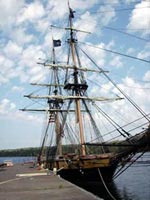 Another article about stowaways, though of a completely different sort – zebra mussels on the Brig Niagara. Earlier this month, the Niagara, a historically accurate reconstruction of Commodore Oliver Hazard Perry’s victorious 1813 flagship, visited Isle Royale, an island National Park in northwestern Lake Superior under terms of a special use permit that required that the ship be free of aquatic invasive species, especially the zebra mussel. Despite the efforts of volunteer divers to clean the hull prior to her arrival, National Park Divers found zebra mussel infestation. After an initial attempt at cleaning the ship was judged too risky, raising the possibility of seeding the harbor with the invasive mussel, the ship left the park and sailed for Duluth.
Another article about stowaways, though of a completely different sort – zebra mussels on the Brig Niagara. Earlier this month, the Niagara, a historically accurate reconstruction of Commodore Oliver Hazard Perry’s victorious 1813 flagship, visited Isle Royale, an island National Park in northwestern Lake Superior under terms of a special use permit that required that the ship be free of aquatic invasive species, especially the zebra mussel. Despite the efforts of volunteer divers to clean the hull prior to her arrival, National Park Divers found zebra mussel infestation. After an initial attempt at cleaning the ship was judged too risky, raising the possibility of seeding the harbor with the invasive mussel, the ship left the park and sailed for Duluth.
Historic Ship Brings Unwelcome Stowaways to Isle Royale National Park
On the morning of July 27th, park divers inspected the hull of the Niagara while it was docked at the headquarters dock on Mott Island. They discovered several colonies of zebra mussels attached to the hull of the ship aft of midship on the keel and rudder assembly (pintel). Evidence suggested that the mussels had been attached to the vessel for a considerable length of time, which meant that the volunteer divers missed them. The park divers cleaned about 80% of the zebra mussels off the hull before deciding that further cleaning of the ship in a clean harbor might seed the harbor and further spread this fast moving invasive species.
The ship left the harbor the next morning with a new level of appreciation for what is necessary to ensure that a ship is 100% clean of aquatic invasive species. The Niagara then sailed to Duluth, Minnesota, to attend the annual Tall Ships Duluth Festival, where it is hoped that the crew of theNiagara will educate the crews of other tall ships and vessels about the issues related to aquatic invasive species such as the zebra mussel.
Zebra mussels are a species that are thought to have originated in the Baltic Sea and are believed to have been transported to the waters of North America in ballast water discharged from commercial shipping vessels. Zebra mussels can attach themselves to nearly any surface, including wood, fiberglass, aluminum, steel, rocks, and pipes, and can be transported to a number of other bodies of water, remaining alive for up to a week out of the water. These fingernail-sized mussels can quickly out-compete native species, change water chemistry and turbidity, change oxygen content, and have significant impact on native fish species.

Pingback: Wood Clearance Blog